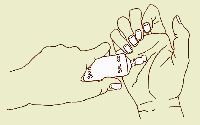
CLEAN UP, SOLVENTS, & THINNERS
Epoxy resin products can be messy and get on surfaces where they are not wanted. They should be removed before they cure to avoid having to grind them away later. This is especially important when gluing around interior areas or on surfaces where visual appearance will be important. While the resin should be cleaned up before it cures, there is no particular rush to remove immediately as it exudes from a joint. In fact, as it stiffens up a bit, removal is actually easier since there won't be as great a tendency to spread it around while it is still fluid, especially the with POXY-SHIELD® due to its thinner viscosity. However, don't wait too long or the resin will cure hard. Nothing can remove the resin at this point other than sanding.
Excess resin can be removed with thin sticks of wood, putty knives, or similar tools. Don't let the uncured epoxy fall to the ground or floor where it will stick to anything and everything or get tracked around; scrape it off into a container. Then wipe surfaces that are to be cleaned using a lint-free rag soaked with a proper solvent.
DENATURED ALCOHOL is the best and probably the safest solvent from a bodily contact standpoint (although it is flammable). Ordinary mineral spirits (paint thinner) is also relatively safe. Other solvents are more hazardous, from a vapor inhalation and/or flammability standpoint, as well as from long-term health affects.
ACETONE is a very effective solvent but has a relatively high evaporation rate, making it necessary to keep the container closed at all times when not in use for safety and economy. The main problem with acetone is that it is highly flammable. Any wood boatbuilding situation offers the potential of a fire hazard, and therefore fire safety is always important.
LAQUER THINNERS are a generic group of solvents which function similarly to acetone, however, there are different formulations. Fumes are also easily detectable in most, but they are not quite as volatile as acetone, yet still considered highly flammable.
TOLUENE, a common constituent of lacquer thinners, is not quite as flammable as acetone nor as volatile, but can reach anesthetic affects at much lower levels. A 50/50 mix of toluene and acetone is sometimes used as a solvent to moderate the qualities of each.
Just about all solvents are dangerous products from one or more respects, and costly. Skin contact should be avoided, especially when working around epoxy products. Most of these products tend to open the skin pores and remove protective skin oils, driving both the solvents and the resin more deeply into the skin and perhaps ultimately into the system of the user. The results are a much greater risk of skin reactions of greater severity.
For personal clean-up of uncured resin from skin, ordinary water and soaps or detergents (including ammonia), or denatured alcohol can be used. However, we prefer the use of waterless hand cleaner products which are specifically intended for use with resin products. These usually have added protective oils that keep the resin from being absorbed by the skin and don't tend to dry the skin. Of course, personal clean-up is much easier if barrier cream has been applied-and protective clothing and gloves worn.
Again it should be emphasized that neither POXY-SHIELD® or POXY-GRIP® products should be thinned with solvents or thinners. This will distort and adversely affect the properties of the resin, perhaps to the point where they simply will not work.